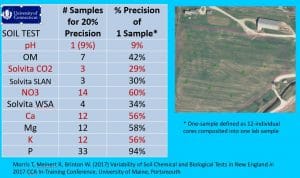
Number of Composite soil samples needed to reach 20% precision. Contrary to assumption, the University survey of 18-farms revealed that soil biology tests were less not more variable than other tests.
A new study about spatial variability of soil tests conducted by University of Connecticut has found that common analyses for OM, K, P, Ca and Mg have much higher variability than thought, ranging between 42 and 93% – in other words, “extremely variable”. The same study compared Solvita CO2, SLAN and WSA-VAST and found these biology tests had lower variability than expected, ranging from 29-34%.
These conclusions are based on samples drawn using 4 sampling regimens on 18 New England farms. Co-workers included samplers from University of Maine cooperative extension, private consultants and Woods End Laboratories. The results were publicly presented at a recent CCA seminar sponsored by University of Maine.
As more labs offer “soil health” tests, concerns have been raised about accuracy and precision of the new procedures. In 2015, Woods End Laboratories identified a major source of variation caused by how soils are moistened for CO2 respiration. A new wetting procedure called 50% WFPS was introduced and has reportedly improved the repeatability in labs across America and in Europe. But skepticism has remained.
The U-Conn study led by Dr. Tom Morris with statistical support from Dr. Karl Guillard used as baseline the ordinary practice of taking 12-random soil cores to be one sample. Under this scenario, the study found variability of lab results ranged from 42% for SOM, 56% for Potassium, 60% for Nitrate and 94% for phosphorus. In comparison, biology tests were less, not more, variable.
The team used a statistical model which calculates how many cores may be required to obtain a given level of precision in lab tests. Using 20% as a reasonable goal, the results indicate much huger quantities of soil cores must be collected than is common practice. For example, Woods End’s Brinton calculated that a set of 12-cores per acre represents only 1-millionth of the population being measured. Given these facts, conference CCA participants expressed concern on the viability of P regulations from lab test results.
The outcome of the study will be used to launch a more intensive examination of soil test variability across a range of farming systems other than Dairy Farms to better understand sources of variation. It may also serve to set realistic targets for soil health tests given the reality of common nutrient analyses. See Report Title

